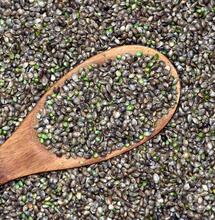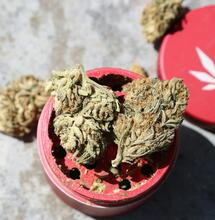Diatomaceous Earth: Kill Bugs in Your Cannabis Garden Without Using Pesticides

Diatomaceous earth is a handy additive and pesticide for Cannabis gardens that also serves multiple health-related and industrial purposes.
Food-grade diatomaceous earth can be used as an anti-caking agent in animal feed.
What Is Diatomaceous Earth?
Sedimentary accumulation of the fossilized remains of marine phytoplankton (or diatoms, a hard-shelled variety of algae) is known as diatomaceous earth (DE), diatomite or by its German name, kieselgur. Around 1836 or 1837, a German wagoner and peasant discovered the substance while constructing a well on Haußelberg hill in northern Germany; since then, the off-white, powdery substance comprised mainly of amorphous silicon dioxide has been used across the world for multiple purposes.
Found in marine deposits, interglacial lake deposits, areas of volcanic activity and occasionally on the surface of desert regions, diatomite has since been utilized in a variety of industrial applications as well as commercial functions. Commercial diatomite typically originates from the Tertiary or Quaternary periods, and this ancient substance is often used in food, drink and grain production as a desiccant, filter or insecticide. Freshwater diatomite is considered food-grade, due to its fine particle size and low silica content (usually below two percent), and is typically the variety used for consumption, health products and pest control. Saltwater DE, often found in swimming pool products, should not be used in the same way due to its high silica content.
How Diatomaceous Earth Keeps a Cannabis Garden Healthy
Dangerous to creatures with an exoskeleton, diatomaceous earth kills insects (such as ants, bed bugs, fleas, cockroaches, mites and aphids or non-insects like spiders and scorpions) by absorbing lipids through the cuticles of their carapace and dehydrating them. Such action is highly effective against arthropods; however, gastropods such as garden slugs may also be controlled using diatomite, although the substance loses efficacy in moist environments. Diatomite scratches the waxy layer of the carapace, thus the insects cannot develop an immunity to the product since the action is physical rather than chemical. However, DE must be utilized properly and consistently in order to prove effective and gardeners using predator mites should only apply diatomaceous earth after the projected end of the predators' life cycle.
Diatomaceous Earth Pesticide Spray
One method of application for Cannabis plants is to create a spray from four tablespoons of food-grade DE per gallon of water. Be careful to measure the diatomaceous earth with a small scoop or spoon in order to reduce airborne dust particles. Shake the mixture to combine, don your spraying mask and mist the plants with a thin, evenly-distributed layer on both the top and undersides of leaves - aim for wet, but not dripping, foliage. This method is only suitable for plants in the vegetative to pre-flower stages, as those in the flowering phase will absorb the spray and it could potentially be consumed when the plant is smoked. Once the spray dries, the diatomite activates and becomes effective.
Dusting with Diatomaceous Earth
Another method for treating plants that are not fully flowering is to dust them from top to bottom with the powder. Using a shaker or dusting canister, shake a fine layer of diatomaceous earth onto morning dew-covered leaves; otherwise, spray the plants with water, shake off the excess liquid and then dust them with the powder. Again, once this mixture dries, the plants will be treated against insect invaders.
If using the dusting or spray methods, make sure to keep the layers thin; otherwise, the DE could block our the sun's rays, preventing photosynthesis. You may need to occasionally rinse the foliage.
DE Soil Treatment
For all-around protection or if the plants are in full flower, you may apply diatomaceous earth evenly to soil that will not be disturbed for a few days, either in a thick ring around the base of plants or plant pots, or across soil beds. Additionally, be sure to reapply after irrigation sessions or rainstorms. Sprinkle a liberal but even layer of DE around infested areas and grow room/garden access routes, while protecting your mucous membranes from any airborne dust from the product. Diatomite is hydrophilic (attracted to water), so it could temporarily irritate your eyes, nose and mouth if precautions are not taken.
It may be a day or two before any effect is noticeable, but infestations from pests like fungus gnats can be controlled with proper application and DE may be used as prophylactic pest control.
Soil growers will find that using diatomite is an effective way to control water saturation, much like perlite or vermiculite, and it also provides a good source of silicon. Silicon is essential for healthy, strong plant cells and tissues and helps to make the plant resistant to environmental stresses. Oxygen circulation is optimal, plus water and nutrients are retained while the substrate drains effectively. Growers with soil gardens usually mix one tablespoon per gallon of dirt; just be careful if you also regularly use humic acid.
Diatomaceous Earth as a Health Supplement
Some folks swear by the health benefits offered by diatomite, but only food-grade products are safe for human consumption. Those with natural lifestyles who focus upon clean food sources may consciously consume as much as a quarter-cup of the powder per day, although eating grains such as bread, pasta and cereal ensures at least a small amount of DE will be eaten as a part of a regular diet, due to its widespread use in the grain industry.
Be sure to find as pure a source of diatomite as possible, whether as a dietary supplement or pesticide - the purpose of using natural goods can be negated when buying commercial products that may be mixed with other ingredients. When scanning labels, be sure to select a product that contains less than 0.5 percent crystalline silica. Try mixing between one teaspoon and two heaping tablespoons of the powder with your favorite juice or other liquid daily to reduce joint pain, for detoxification or as a colon cleanser. Silica also assists in nutrient absorption - especially calcium, helping to prevent osteoporosis - and may also be used for its anti-aging properties, as an appetite suppressant assisting in weight loss, to increase energy levels, reduce high blood pressure and cholesterol and to strengthen hair, nails, teeth and gums.
Non-Gardening Applications for Diatomaceous Earth
Industrially, diatomite is used as a dynamite stabilizer, as nitroglycerine absorbed into diatomite can be more stable, but also a filler that reinforces plastics and rubber, a matting agent for coating materials, an activator for blood-clotting studies and many other applications. For thermal purposes, diatomaceous earth provides an excellent heat barrier for items such as cooking stoves/ovens and acts as insulation against fires.
Its relation to more common household products can be found through the use of diatomite as a mild abrasive, its oldest-known application, in toothpaste manufacture as well as its occasional employ in face scrubs and metal polish.
Filtration and clarification is one of the most widespread use of the substance, due to its high porosity. The saltwater type of diatomite is applied in swimming pools and fish tanks but may also be used to filter wine, beer, honey, sugar and drinking water. This variety contains larger particles than freshwater diatomite and a high silica content, upwards of sixty percent; therefore, saltwater diatomite is unsuitable for use as an insecticide or for human consumption, as it is treated (calcinated) before use in order to remove volatile compounds and impurities. Those applying it must maintain caution to prevent inhalation of the crystalline version of the silica-rich powder, as it can cause respiratory damage.
As an absorptive or desiccant, freshwater diatomite may be found as an ingredient in cat litter or applied to oil and liquid chemical spills for cleanup. It also absorbs ethylene gas, which prevents rotting of vegetables and fruit, and may be used in combination with refrigeration in order to sustain fresh produce and extend its shelf life. Diatomite also dries out facial oil, serving a dual purpose in face scrubs and masks, and it is also utilized to prevent caking or clumping - and control insect infestations - in animal feed.
In addition to being an effective feed-stock additive, it is also a natural anthelmintic (de-wormer) that can be applied to both humans and livestock or pets.



